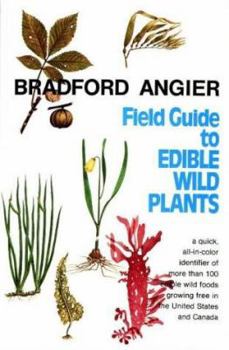Field Guide to Edible Wild Plants
Select Format
Select Condition 
Book Overview
First-ever revision of a classic guidebookEssential information on each plant's characteristics, distribution, and edibility as well as updated taxonomy and 18 new speciesHow to find, prepare, and eat... This description may be from another edition of this product.
Format:Paperback
Language:English
ISBN:0811720187
ISBN13:9780811720182
Release Date:August 1974
Publisher:Stackpole Books
Length:2 Pages
Weight:0.84 lbs.
Dimensions:0.5" x 5.5" x 8.2"
Customer Reviews
6 ratings
Good for Info, Less so for Identifying
Published by Dan Delgado , 1 month ago
There is ample information about well over 100 plants. There are two drawbacks though.
The pictures in the book are all drawn and colored. This gives a decent depiction of each plant, but there is no way I would trust identifying berries or mushrooms based on illustrations!
The plants are all thrown in Willy-nilly. There is no table of contents to identify chapters, such as Berries, Nuts, Seeds, Herbs, etc. Rather, the index with plant names and pages numbers are all at the front. Even if the plants were all listed alphabetically there would be an obvious, though less ideal, organizational structure. Instead there are stems, followed by flowers, another stem or two, some seeds, pollen, nuts, etc all simply thrown together. If I want to know if a berry is edible or poisonous, it would be very helpful if I could simply turn to the berry section and see a photograph instead of flipping through pages in the hopes of coming across an illustration that looks “closest” to what is at hand.
If you know of a few plants already and want to know about distribution and most edible parts and how to prepare them (raw, boiled, steamed, etc.) then this book is an excellent resource. As a field guide it isn’t practical enough.
Good book
Published by Thriftbooks.com User , 17 years ago
I owned this before and I remember it seeming more durable but it is well written.
A good book
Published by Thriftbooks.com User , 17 years ago
This book first caught my attention in the 70s but over the years I had lost my original copy so I repurchased one. It is still a good book even though the pictures are all rendered as art, which makes me a little nervous on critical IDs. I enjoy the details on preparing the plants, some of which were apparently as the native Americans had done. It is a very good companion book to some of the more recent works out there such as the North American Guide to Edible Wild Plants.
Better than many others
Published by Thriftbooks.com User , 22 years ago
I find this one useful. Drawings are not "natural" but compensate by revealing all major parts clearly: root, leaf, flower, stems. Anyway, I find one needs at least two books for reliable identity and often for any ID at all. Variations among species make identity of individual plants a lot harder than it might seem, excepting for a few easy plants like cat tails, purslane, etc. I agree with a prior reviewer that absence of poisonous plants is unfortunate. Also, absence of scientific names is not good, since common names aren't reliable.
Saved my Life!
Published by Thriftbooks.com User , 24 years ago
When I was stranded with my dog in the Alaska Wilderness for a week and a half, this book saved my life. Without it, how could I have eaten well until the aircraft came - yes, you heard - eaten well! I thank Bradford Angier greatly for this wonderful text!
Great book if you already know some plants...
Published by Thriftbooks.com User , 25 years ago
And still ok if you're clueless. The book's small size, a convenience in the field, limits the amount of illustrations it can contain. For example, the entire gooseberry/currant family is represented by three pictures, all fitting on one page. The text, on the other hand, can't be matched. My suggestion would be to pair this book with a field guide to wild plants until you can recognise them by sight.







